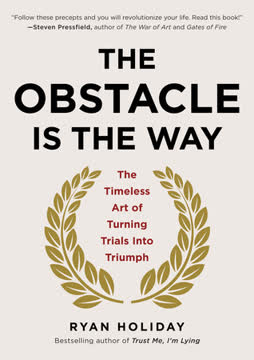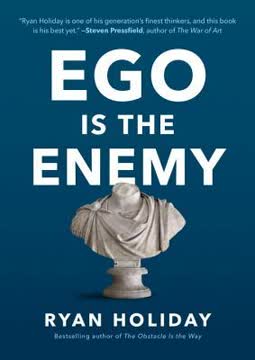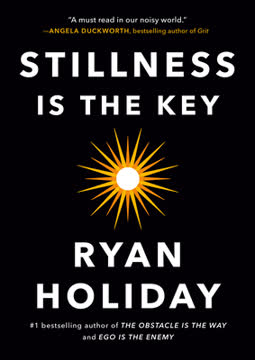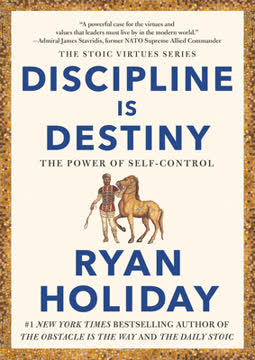つの重要なポイント
1. 実践的な人生哲学としてのストア派を受け入れる
「誰がそんな男を憎まないだろうか?」
ストア派の生き方。 ストア派は、賢明かつ徳を持って生きるための実践的なアプローチを提供します。主に自分の思考や行動に焦点を当て、外部の出来事を平静に受け入れることを強調します。この哲学は、外部の快楽や物質的な所有物を追求するのではなく、徳と知恵を育むことから真の幸福が得られると教えています。
ストア派の主要な実践:
- 定期的な自己反省と日記
- 感謝と満足の実践
- 逆境を想像してレジリエンスを築く
- 合理的な思考と感情の調整を育む
- 倫理的な行動と社会的責任に焦点を当てる
ストア派は、個人の成長と感情のレジリエンスのための枠組みを提供し、人生の挑戦をより冷静かつ目的を持って乗り越えることを可能にします。
2. 合理的な思考を通じて内なる平和を育む
「宇宙は変化であり、人生は意見である。」
合理的な視点。 ストア派は、出来事そのものではなく、出来事に対する我々の判断が苦痛を引き起こすと教えています。合理的な思考を育むことで、より大きな内なる平和と感情の安定を達成できます。これには、信念や仮定を検証し、事実と意見を分け、状況をより客観的に見ることが含まれます。
合理的な思考のための技術:
- 非合理的な思考を特定し挑戦する
- 認知的再構成を実践する
- 「上からの視点」技術を使って視点を得る
- 自分のコントロールできることに焦点を当てる
- 変化と無常を受け入れる
より合理的な見方を育むことで、不必要な苦しみを減らし、人生の浮き沈みに対して平静を保つことができます。
3. 感情を管理するための認知的距離を実践する
「私たちを動揺させるのは出来事ではなく、それに対する私たちの判断である。」
感情の調整。 認知的距離は、感情を管理するための重要なストア派の技術です。これは、自分自身と自分の思考や感情の間に精神的な空間を作り、状況をより客観的に評価することを可能にします。この実践は、自動的な感情反応を防ぎ、挑戦的な状況に対してより思慮深い反応を促進します。
認知的距離のステップ:
- 思考は事実ではないことを認識する
- 思考や感情を判断せずに観察する
- 距離を作る言葉を使う(例:「私は...という思考を持っている」)
- 外部の視点から状況を見ることを想像する
- 合理的な評価のために反応を遅らせる
認知的距離をマスターすることで、感情反応をよりコントロールし、逆境に対して平静を保つことができます。
4. 自制心を通じて不健康な欲望を克服する
「怒ることは男らしくない。むしろ穏やかで優しい性格がより男らしい。なぜならそれがより人間的だからだ。」
欲望の克服。 ストア派は、不健康な欲望を克服し、徳のある行動を育むための自制心の重要性を強調します。これは、真の充実感は理性と徳に従って生きることから得られるのであり、一時的な快楽や過度の物質的追求にふけることではないと認識することを含みます。
自制心を育むための戦略:
- 遅延満足を実践する
- 定期的に自発的な不快感に従事する
- 価値に沿った明確な目標を設定する
- 一貫した実践を通じて健康的な習慣を育む
- 不健康な欲望に屈することの結果を反省する
欲望をマスターすることで、より大きな自由と満足を達成し、人生で本当に重要なことにエネルギーを集中させることができます。
5. 苦痛と逆境に直面してレジリエンスを育む
「自然によって耐えられないことは誰にも起こらない。」
精神的な強さを築く。 ストア派は、逆境が人生の避けられない一部であり、レジリエンスを育むためのツールを提供します。挑戦を成長の機会として再構築し、痛みを人間の経験の自然な一部として見ることで、精神的な強さを築き、困難な時期に平静を保つことができます。
レジリエンスを育むための技術:
- ネガティブな視覚化を実践する
- コントロールできることに焦点を当てる
- 成長マインドセットを育む
- 逆境に意味を見出す
- 過去の挑戦を乗り越えた経験から学ぶ
レジリエンスを育むことで、人生の困難に対してより大きな勇気と冷静さを持って対処し、最終的には個人的な成長と内なる強さを得ることができます。
6. 共感と理解を通じて怒りをマスターする
「眠っているかのように行動し、話すべきではない。」
怒りの管理。 ストア派は、共感と理解を促進することで怒りを管理するための強力な戦略を提供します。人々の行動が無知や誤解によって引き起こされることが多いと認識することで、挑発に対してより忍耐強く、思いやりを持って対応することができます。
怒りをマスターするためのアプローチ:
- 引き金となる状況の認知的再構成を実践する
- 他者の視点を考慮して共感を育む
- 反応する前に「一時停止」技術を使う
- 感情的な発散ではなく合理的な問題解決に焦点を当てる
- 怒りがしばしば怒っている人自身に害を及ぼすことを思い出す
怒りをマスターすることで、より良い人間関係を維持し、賢明な決定を下し、内なる平和を保つことができます。
7. 平静と受容を持って死に直面する
「死ぬことを学ぶことは、奴隷であることを忘れることだ。」
死を受け入れる。 ストア派は、死を受け入れることが充実した人生を送るための鍵であると教えています。定期的に死を瞑想し、それを存在の自然な一部として見ることで、私たちを麻痺させる恐怖を克服し、より真実で目的を持って生きることができます。
死に直面するための実践:
- 定期的な死の瞑想
- 人生で本当に重要なことを優先する
- 毎日を最後の日のように生きる
- 持っている時間に感謝する
- 残したい遺産について反省する
死に平静を持って直面することで、逆説的に人生への感謝を高め、本当に重要なことに焦点を当てることができ、より意味のある目的のある存在を送ることができます。
最終更新日:
FAQ
What's How to Think Like a Roman Emperor about?
- Exploration of Stoicism: The book delves into the life and philosophy of Marcus Aurelius, focusing on how his Stoic beliefs influenced his leadership and character.
- Personal Journey: Donald J. Robertson intertwines his own experiences with Stoicism, demonstrating its relevance to modern life.
- Practical Philosophy: It emphasizes Stoicism as a practical philosophy, offering techniques and exercises for emotional resilience and moral integrity.
Why should I read How to Think Like a Roman Emperor?
- Timeless Wisdom: Gain insights from Marcus Aurelius's reflections, which address contemporary challenges like anxiety and stress.
- Self-Improvement Tools: The book provides practical exercises and methods from Stoic philosophy for personal development.
- Engaging Narrative: Robertson combines historical anecdotes with personal stories, making philosophical concepts accessible and engaging.
What are the key takeaways of How to Think Like a Roman Emperor?
- Emotional Resilience: Learn to manage emotions through Stoic practices for greater emotional stability.
- Virtue as the Highest Good: True fulfillment comes from living virtuously, not from external pleasures or material wealth.
- Perspective on Mortality: Contemplating mortality fosters a deeper appreciation for life and reduces the fear of death.
What are the best quotes from How to Think Like a Roman Emperor and what do they mean?
- "Waste no more time arguing about what a good man should be; just be one.": Encourages action over debate, emphasizing embodying virtue.
- "It’s not things that upset us but our judgments about things.": Highlights the Stoic belief that emotions are shaped by perceptions, not events.
- "Know Thyself.": Calls for self-awareness, underscoring the importance of understanding one's thoughts and motivations.
What is Stoicism, as described in How to Think Like a Roman Emperor?
- Philosophy of Life: Stoicism is a way of life emphasizing rationality, virtue, and emotional resilience.
- Core Virtues: Advocates for wisdom, justice, courage, and moderation to guide ethical behavior.
- Indifference to External Events: Teaches that external circumstances are indifferent; what matters is responding with virtue and reason.
How does Marcus Aurelius exemplify Stoic principles in his life?
- Personal Reflections: Through The Meditations, Marcus reflects on his struggles and Stoic practices to maintain composure and virtue.
- Facing Adversity: Despite challenges like wars and personal losses, he remained committed to Stoic ideals, demonstrating resilience.
- Role Model: Marcus serves as a model for applying Stoicism in leadership, guiding ethical governance and personal conduct.
How does How to Think Like a Roman Emperor connect Stoicism with modern psychotherapy?
- Cognitive-Behavioral Therapy (CBT): The book draws parallels between Stoic techniques and modern CBT practices, addressing emotional distress through rational thinking.
- Therapeutic Exercises: Many Stoic exercises are early forms of psychological techniques used in contemporary therapy.
- Emotional Resilience: Both Stoicism and modern therapy emphasize developing resilience and coping strategies for life's challenges.
What specific methods or exercises does How to Think Like a Roman Emperor recommend for practicing Stoicism?
- Morning and Evening Meditations: Reflect on values and actions daily to cultivate self-awareness.
- Cognitive Distancing: Practice separating emotional responses from external events for a rational perspective.
- Values Clarification: Identify and write down personal values to align daily actions with what is truly important.
How does How to Think Like a Roman Emperor address the concept of fear?
- Premeditation of Adversity: Visualizing potential fears and challenges prepares individuals to face them calmly.
- Cognitive Distancing: Recognize that fear often stems from judgments about potential outcomes.
- Acceptance of Uncertainty: Encourages acceptance of uncertainty, alleviating the burden of fear.
What strategies does Marcus Aurelius use to cope with anger in How to Think Like a Roman Emperor?
- Self-Monitoring: Be aware of early signs of anger, such as physical tension or negative thoughts.
- Cognitive Distancing: Understand that anger arises from judgments about others' actions, not the actions themselves.
- Empathy and Understanding: View others as flawed humans acting out of ignorance, fostering compassion.
What is the significance of the "reserve clause" in How to Think Like a Roman Emperor?
- Acceptance of Uncertainty: Acknowledge that outcomes are not entirely under control, reducing anxiety.
- Focus on Virtue: Prioritize virtuous actions over specific outcomes, emphasizing intention.
- Emotional Detachment: Maintain composure regardless of outcomes, fostering resilience.
How does How to Think Like a Roman Emperor address the theme of death?
- Contemplation of Mortality: Reflect on mortality to live more fully and reduce fear of death.
- Acceptance of Change: Emphasizes that death is a natural part of life and should be accepted.
- Perspective Shift: View death as a return to Nature, alleviating fear and encouraging a balanced view of life and death.
レビュー
『ローマ皇帝のように考える方法』は、ストア派哲学、マルクス・アウレリウスの伝記、現代心理学を融合させた読みやすい内容で高く評価されている。読者は、ロバートソンが古代の知恵を現代生活に関連付ける能力を称賛し、ストア派哲学と認知行動療法の間に類似点を見出している。この本は、感情の管理、レジリエンスの発展、美徳の育成に関する実践的なアドバイスで称賛されている。多くの人々は、この本が教育的であり、かつインスピレーションを与えるものであり、ストア派の原則とその日常生活への応用について貴重な洞察を提供していると感じている。一部のレビュアーは、ストア派哲学とマルクス・アウレリウスの入門書としての効果を指摘している。
Similar Books



















